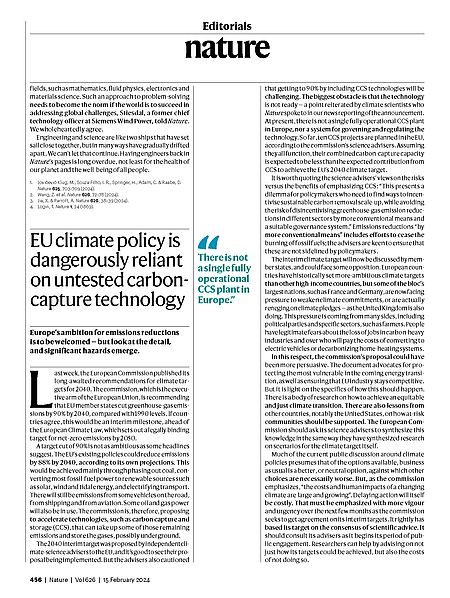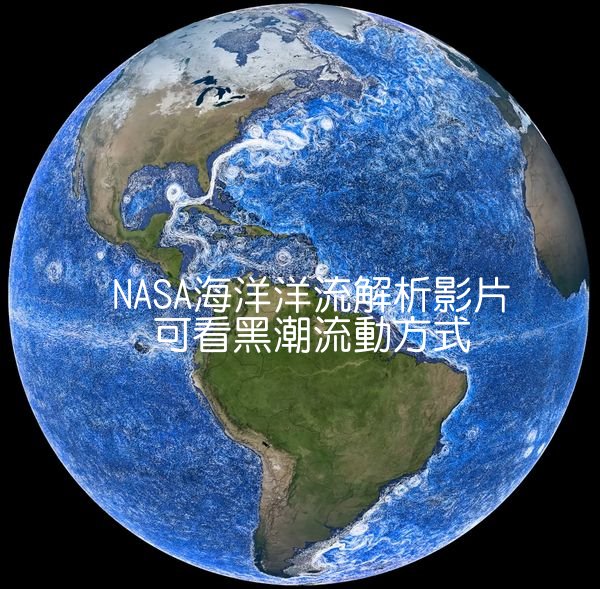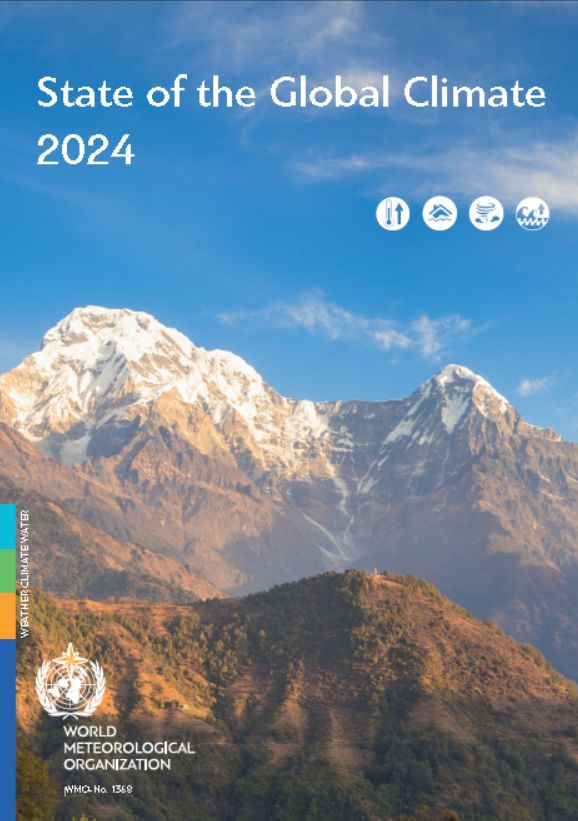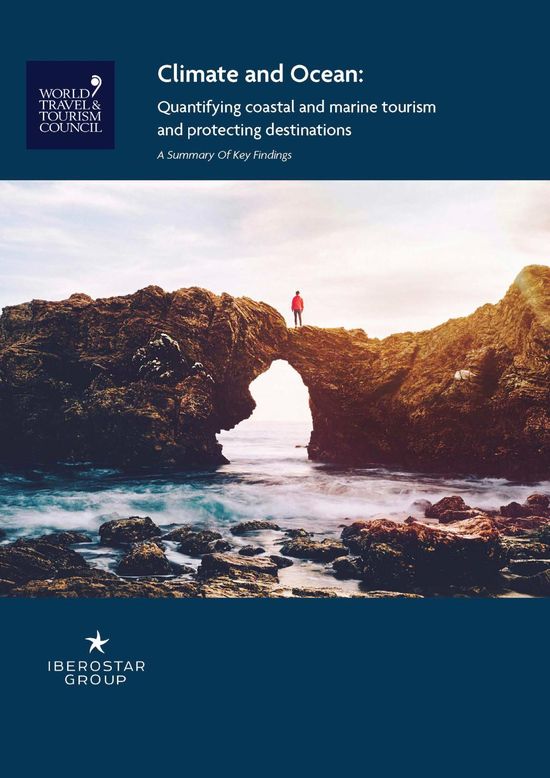2024年2月6日,歐盟執行委員會公布了人們期待已久的 2040 年氣候目標。該委員會是歐盟的執行機構,建議歐盟成員國將2040年溫室氣體排放量相較1990年水準削減90%。
不過, 2月15日出版的權威期刊《自然》(Nature)第626卷社論警告,雖然歐盟減排目標雄心勃勃,但依賴未經證實的碳捕獲和封存(CCS)技術,所提出的氣候政策是相當危險的。
根據歐盟自己的預測,到 2040 年,歐盟現有政策即可以將排放量減少 88%。 這主要透過逐步淘汰煤炭、將大部分化石燃料發電轉化為太陽能、風能和潮汐能等再生能源以及交通電氣化來實現。不過道路上的一些車輛、航運和航空仍然會有所排放,而一些石油和天然氣發電也仍投入使用。 因此,該委員會提議加快碳捕集與封存(Carbon Capture and Storage, CCS)等技術的發展,這些技術可以吸收一些剩餘的排放物,並可能將氣體儲存在地下。
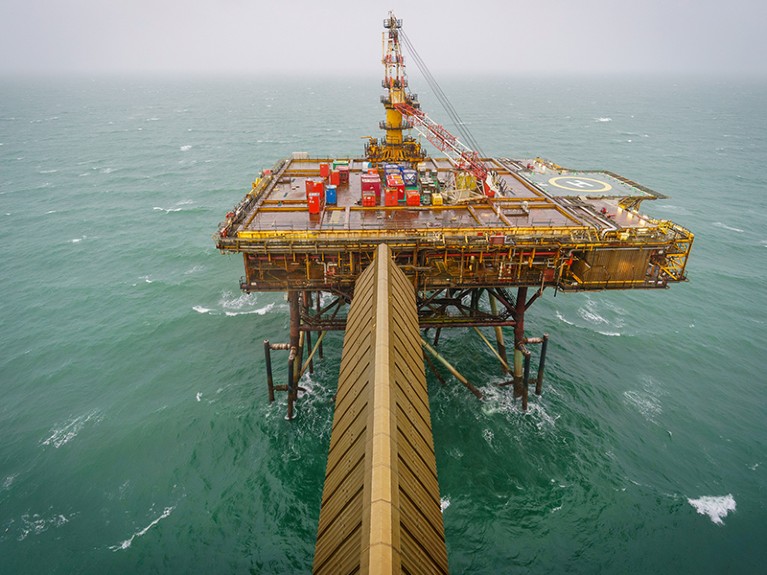
2040 年減排目標是歐盟獨立氣候科學顧問提出的,不過顧問也警告,透過採用 CCS 技術來達到 90% 的目標是具有挑戰性的。最大的障礙是這項技術還沒準備好——《自然》期刊在新聞報導中也重申了這一點。目前,歐洲還沒有一個全面運作的 CCS 工廠,也沒有一個管理和調節該技術的系統。 據該委員會科學顧問稱,到目前為止,歐盟計劃實施 10 個 CCS 項目。 假設它們全都發揮作用,其碳捕集總和也將低於 CCS 對實現歐盟 2040 年氣候目標的預期貢獻。
值得注意的是科學顧問強調 CCS 的風險與利益的看法:「這給政策制定者帶來了兩難的處境,他們需要找到新方法來激勵可持續的碳清除規模,同時要避免壓抑不同部門以更傳統的方式和合適的治理體系來減少碳排放。」所謂「透過更傳統的方式減排」包括努力停止燃燒化石燃料; 顧問們熱切希望確保政策制定者不會忽視這些工作。
此中期氣候目標將由成員國討論,並可能面臨一些反對。 歐洲國家歷來設定了比其他高收入國家更雄心勃勃的氣候目標,但法國和德國等歐盟最大的國家現在面臨著削弱氣候承諾的壓力,甚至實際上正在違背氣候承諾——因為英國也如此。 這種壓力來自多方面,包括政黨和農民等特定部門。 人們對高碳產業失業以及誰將支付轉購電動車或家庭暖氣系統脫碳所增加的成本有所疑慮,這些擔憂是合理的。
原文網頁版:EU climate policy is dangerously reliant on untested carbon-capture technology
原文PDF檔:https://www.nature.com/articles/d41586-024-00391-3.pdf
- EDITORIAL
EU climate policy is dangerously reliant on untested carbon-capture technology

Carbon-capture technology, such as this plant in the Irish Sea, is at the research, development and demonstration stage.Credit: Dominic Lipinski/Bloomberg/Getty
Last week, the European Commission published its long-awaited recommendations for climate targets for 2040. The commission, which is the executive arm of the European Union, is recommending that EU member states cut greenhouse-gas emissions by 90% by 2040, compared with 1990 levels. If countries agree, this would be an interim milestone, ahead of the European Climate Law, which sets out a legally binding target for net-zero emissions by 2050.
A target cut of 90% is not as ambitious as some headlines suggest. The EU’s existing policies could reduce emissions by 88% by 2040, according to its own projections. This would be achieved mainly through phasing out coal, converting most fossil-fuel power to renewable sources such as solar, wind and tidal energy, and electrifying transport. There will still be emissions from some vehicles on the road, from shipping and from aviation. Some oil and gas power will also be in use. The commission is, therefore, proposing to accelerate technologies, such as carbon capture and storage (CCS), that can take up some of those remaining emissions and store the gases, possibly underground.
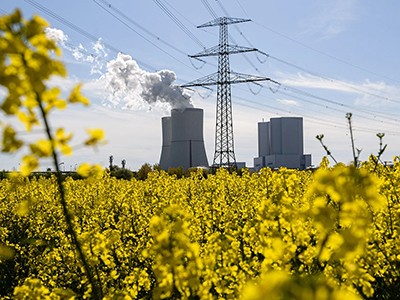
EU unveils controversial climate target: what scientists think
The 2040 interim target was proposed by independent climate-science advisers to the EU, and it’s good to see their proposal being implemented. But the advisers also cautioned that getting to 90% by including CCS technologies will be challenging. The biggest obstacle is that the technology is not ready — a point reiterated by climate scientists who Nature spoke to in our news reporting of the announcement. At present, there is not a single fully operational CCS plant in Europe, nor a system for governing and regulating the technology. So far, ten CCS projects are planned in the EU, according to the commission’s science advisers. Assuming they all function, their combined carbon-capture capacity is expected to be less than the expected contribution from CCS to achieve the EU’s 2040 climate target.
It is worth quoting the science advisers’ views on the risks versus the benefits of emphasizing CCS: “This presents a dilemma for policymakers who need to find ways to incentivise sustainable carbon removal scale-up, while avoiding the risk of disincentivising greenhouse-gas emission reductions in different sectors by more conventional means and a suitable governance system.” Emissions reductions “by more conventional means” includes efforts to cease the burning of fossil fuels; the advisers are keen to ensure that these are not sidelined by policymakers.
The interim climate target will now be discussed by member states, and could face some opposition. European countries have historically set more-ambitious climate targets than other high-income countries, but some of the bloc’s largest nations, such as France and Germany, are now facing pressure to weaken climate commitments, or are actually reneging on climate pledges — as the United Kingdom is also doing. This pressure is coming from many sides, including political parties and specific sectors, such as farmers. People have legitimate fears about the loss of jobs in carbon-heavy industries and over who will pay the costs of converting to electric vehicles or decarbonizing home-heating systems.
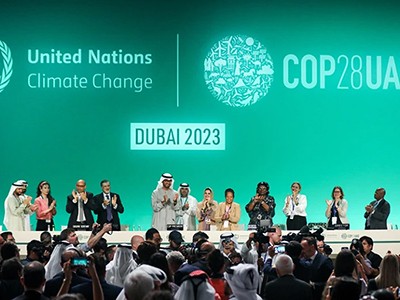
COP28 climate summit signals the end of fossil fuels — but is it enough?
In this respect, the commission’s proposal could have been more persuasive. The document advocates for protecting the most vulnerable in the coming energy transition, as well as ensuring that EU industry stays competitive. But it is light on the specifics of how this should happen. There is a body of research on how to achieve an equitable and just climate transition. There are also lessons from other countries, notably the United States, on how at-risk communities should be supported. The European Commission should ask its science advisers to synthesize this knowledge in the same way they have synthesized research on scenarios for the climate target itself.
Much of the current public discussion around climate policies presumes that of the options available, business as usual is a better, or neutral option, against which other choices are necessarily worse. But, as the commission emphasizes, “the costs and human impacts of a changing climate are large and growing”. Delaying action will itself be costly. That must be emphasized with more vigour and urgency over the next few months as the commission seeks to get agreement on its interim targets. It rightly has based its target on the consensus of scientific advice. It should consult its advisers as it begins its period of public engagement. Researchers can help by advising on not just how its targets could be achieved, but also the costs of not doing so.
Nature 626, 456 (2024)
doi: https://doi.org/10.1038/d41586-024-00391-3
延伸閱讀:
2020至2024年這五年中,地球將可能再創高溫紀錄(中英對照)
2019年氣候統計及30秒看地球140年逐漸發燒狀況(影片、圖片、數據)
北極冰況消融危機持續惡化-2018北極報告摘要(影片、相片、數據)-中英對照
Alaska salmon woes, extreme precipitation, tundra shrub growth part of Arctic transformation

